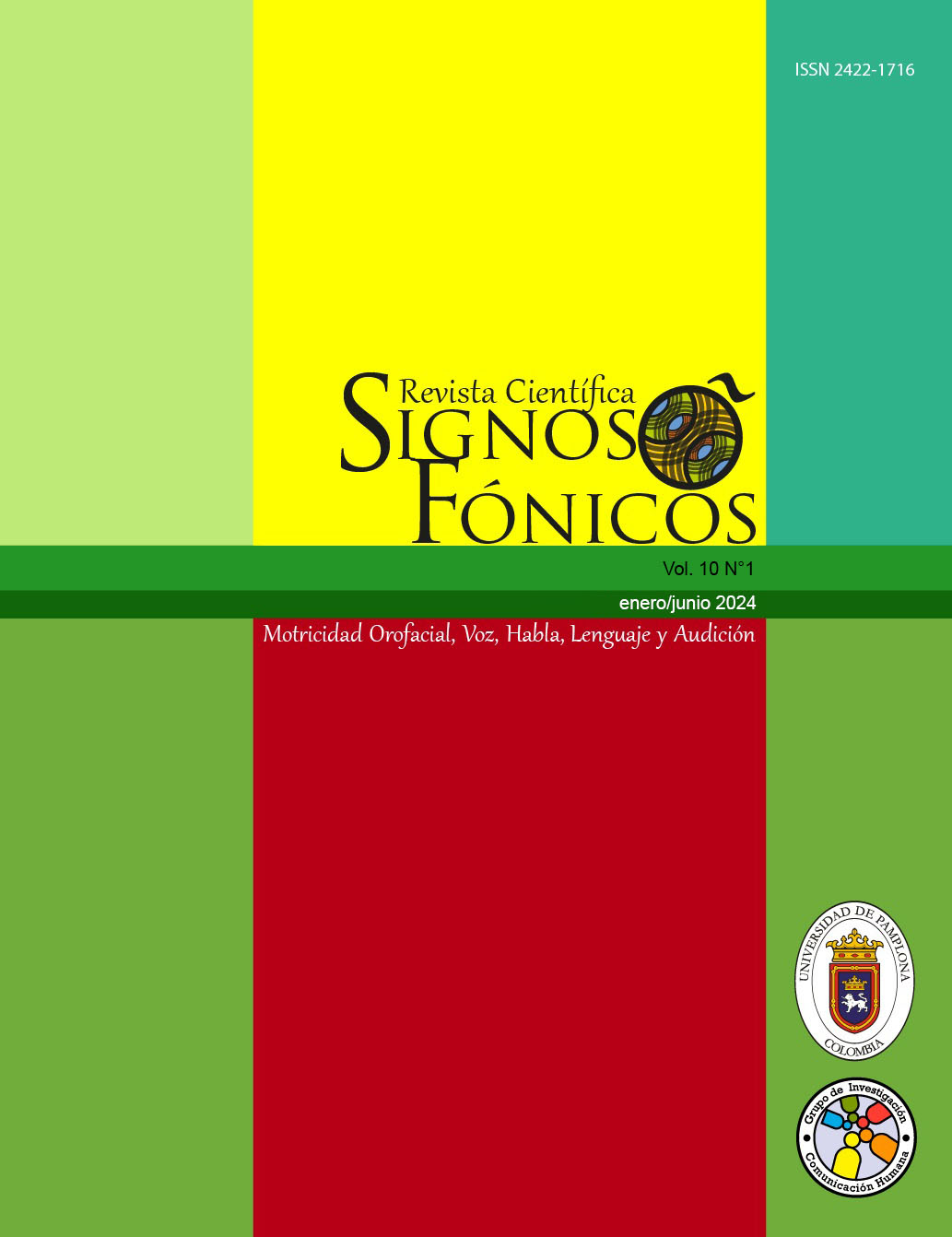Caracterización de resultados de la evaluación fibroscópica de la deglución en los niveles IDDSI 0,3 y 7 según la Escala de Penetración Aspiración
DOI:
https://doi.org/10.24054/rcsf.v10i1.3053Palabras clave:
Deglución, Trastornos de la deglución, diagnóstico, fisiopatología, otorrinolaringología, fonoaudiologíaResumen
INTRODUCCION: Establecer la severidad de la disfagia a través de la Escala de Penetración Aspiración según niveles IDDSI 0, 3 y 7 en sujetos adultos derivados a evaluación fibroscópica de la deglución por sospecha de disfagia en el Hospital San Camilo de San Felipe. Métodos: Estudio de enfoque cualitativo, alcance correlacional y diseño no transversal y experimental transversal y muestreo por conveniencia. incluyeron 30 personas (entre 20 y 92 años) derivadas a evaluación fibroscópica de la deglución, con Glasgow 15 y con S5Q menor o igual 4/5. Se consignaron los resultados obtenidos mediante la Escala de Penetración-Aspiración de los niveles 0,3 y 7 de la Iniciativa Internacional de Estandarización de la Dieta para la Disfagia. Resultados: El promedio de edad correspondió a 60 años, el 26,7% presentaba patologías neurológicas y el 16,7% enfermedades respiratorias. En el 76,7% de los participantes no se objetivó entrada de material a vía aérea (PAS=1) en todas las consistencias y medidas evaluadas, el 13,3% evidenció alteraciones de la seguridad con IDSSI 0, el 6,6% en IDSSI 3 y el 10% con IDSSI 7. Conclusiones: Este estudio proporciona una caracterización del examen FEES en una muestra local, así mismo se observa la necesidad de contar a nivel nacional con un protocolo FEES estándar que permita homologar criterios.
Descargas
Referencias
Murry T, Carrau RL, Chan KMK. Clinical management of swallowing disorders [Internet]. 5.a ed. San Diego: Plural Publishing; 2022 [citado 27 de abril de 2021]. 350 p. Disponible en: https://search.ebscohost.com/login.aspx?direct=true&scope=site&db=nlebk&db=nlabk&AN=2680663
Roden DF, Altman KW. Causes of Dysphagia Among Different Age Groups. Otolaryngologic Clinics of North America. diciembre de 2013;46(6):965-87.
Rommel N, Hamdy S. Oropharyngeal dysphagia: manifestations and diagnosis. Nat Rev Gastroenterol Hepatol. enero de 2016;13(1):49-59.
Saitoh E, Pongpipatpaiboon K, Inamoto Y, Kagaya H, editores. Dysphagia Evaluation and Treatment [Internet]. Singapore: Springer Singapore; 2018 [citado 27 de abril de 2021]. Disponible en: http://link.springer.com/10.1007/978-981-10-5032-9
Thiyagalingam S, Kulinski AE, Thorsteinsdottir B, Shindelar KL, Takahashi PY. Dysphagia in Older Adults. Mayo Clinic Proceedings. febrero de 2021;96(2):488-97.
Yoon JA, Kim SH, Jang MH, Kim SD, Shin YB. Correlations between Aspiration and Pharyngeal Residue Scale Scores for Fiberoptic Endoscopic Evaluation and Videofluoroscopy. Yonsei Med J. 2019;60(12):1181.
Jiménez-Domínguez R, Manzano-Aquiahuatl C. Fiberoptic endoscopic evaluation of the swallowing in neurogenic dysphagia: A proposal of an algorithm for fiberoptic endoscopic evaluation of the swallowing in neurology hospitals in Mexico. RMN. 11 de octubre de 2021;22(5):6919.
Nazar G, Ortega T A, Godoy M A, Godoy M JM, Fuentealba M I. Evaluación fibroscópica de la deglución. Rev Otorrinolaringol Cir Cabeza Cuello [Internet]. agosto de 2008 [citado 13 de octubre de 2019];68(2). Disponible en: http://www.scielo.cl/scielo.php?script=sci_arttext&pid=S0718-48162008000200004&lng=en&nrm=iso&tlng=en
Verin E, Clavé P, Bonsignore MR, Marie JP, Bertolus C, Similowski T, et al. Oropharyngeal dysphagia: when swallowing disorders meet respiratory diseases. Eur Respir J. abril de 2017;49(4):1602530.
Donzelli J, Wesling M, Brady S, Craney M. Predictive Value of Accumulated Oropharyngeal Secretions for Aspiration during Video Nasal Endoscopic Evaluation of the Swallow. Ann Otol Rhinol Laryngol. mayo de 2003;112(5):469-75.
Alkhuwaiter M, Davidson K, Hopkins-Rossabi T, Martin-Harris B. Scoring the Penetration–Aspiration Scale (PAS) in Two Conditions: A Reliability Study. Dysphagia. abril de 2022;37(2):407-16.
Colodny N. Interjudge and Intrajudge Reliabilities in Fiberoptic Endoscopic Evaluation of Swallowing (Fees ) Using the Penetration-Aspiration Scale: A Replication Study. Dysphagia. 1 de diciembre de 2002;17(4):308-15.
Langmore SE, Kenneth SMA, Olsen N. Fiberoptic endoscopic examination of swallowing safety: A new procedure. Dysphagia. diciembre de 1988;2(4):216-9.
Cabezón A R, Ramírez R C, Badía V P, León M N, Fonseca A X. Evaluación de la deglución con nasofibroscopia en pacientes hospitalizados: factores predictivos y seguimiento intrahospitalario: Experiencia en un hospital clínico universitario. Rev méd Chile. agosto de 2011;139(8):1025-31.
Mann G, Hankey GJ. Initial Clinical and Demographic Predictors of Swallowing Impairment Following Acute Stroke. Dysphagia. agosto de 2001;16(3):208-15.
Cho SY, Choung RS, Saito YA, Schleck CD, Zinsmeister AR, Locke GR, et al. Prevalence and risk factors for dysphagia: a USA community study. Neurogastroenterol Motil. febrero de 2015;27(2):212-9.
Langmore SE, Scarborough DR, Kelchner LN, Swigert NB, Murray J, Reece S, et al. Tutorial on Clinical Practice for Use of the Fiberoptic Endoscopic Evaluation of Swallowing Procedure With Adult Populations: Part 1. Am J Speech Lang Pathol. 18 de enero de 2022;31(1):163-87.
Choi JB, Jung YJ, Park JS. Comparison of 2 types of therapeutic exercise: jaw opening exercise and head lift exercise for dysphagic stroke: A pilot study. Medicine. 18 de septiembre de 2020;99(38):e22136.
Descargas
Publicado
Número
Sección
Licencia
Derechos de autor 2024 Amalia Nanjarí R., María del Carmen Campos

Esta obra está bajo una licencia internacional Creative Commons Atribución-NoComercial-SinDerivadas 4.0.











